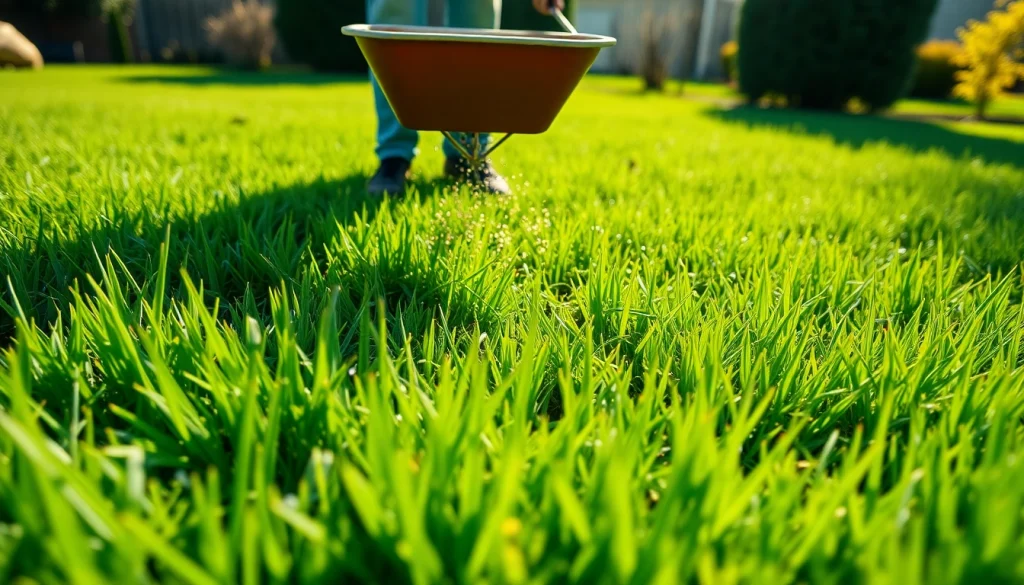Understanding Over Seeding
What is Over Seeding?
Over seeding is a lawn care practice that involves planting grass seed directly into existing turf without the need for tearing up the ground or soil. This technique aims to improve the density, color, and overall health of the lawn by introducing new grass varieties or replenishing the existing grass. The process can also serve to fill in bare patches and thickens the grass cover, making it more resilient to various environmental stresses. For many homeowners and landscape professionals, over seeding is a key strategy in maintaining a lush, vibrant lawn that withstands the demands of seasonal changes and foot traffic.
Benefits of Over Seeding Your Lawn
Over seeding offers numerous benefits that can greatly enhance the appearance and health of your lawn. Understanding these advantages can help homeowners recognize why they might consider it as a routine lawn maintenance activity.
- Enhances Lawn Density: One of the primary benefits of over seeding is the improved density of grass. By introducing new seeds, you encourage thick growth that helps choke out weeds.
- Improves Color and Texture: Over seeding can revitalize a lackluster lawn. Introducing newer grass species can result in a greener, healthier-looking turf.
- Fills Bare Spots: Bare patches caused by wear, drought, or disease can be effectively covered through over seeding, leading to a uniform lawn appearance.
- Increases Drought Resistance: By incorporating drought-resistant grass varieties, over seeding can improve your lawn’s ability to withstand dry spells.
- Reduces Pests and Weeds: A dense lawn not only looks better but can also act as a barrier against invasive weeds and annoying pests, reducing the need for herbicides and pesticides.
- Boosts Resilience: With multiple varieties growing together, the lawn is more resilient, surviving environmental changes like temperature fluctuations and varying precipitation.
Common Misconceptions about Over Seeding
Despite its benefits, over seeding is often surrounded by misconceptions that may deter homeowners from trying it. Let’s explore and debunk some of these myths:
- Myth 1: Over seeding is only for damaged lawns. Many believe that only lawns in decline or suffering damage need over seeding. In reality, even healthy lawns can benefit from the practice to maintain vibrancy and density.
- Myth 2: Any seed can be used for over seeding. It’s crucial to select grass varieties that are compatible with existing grass types, particularly regarding growth habits and regional adaptability.
- Myth 3: Visible results come instantly. Overseeding can require patience; the new grass may take time to establish and flourish, depending on the grass type and environmental factors.
- Myth 4: There’s no preparation needed before over seeding. Proper lawn preparation is essential for successful results. This includes mowing, raking, and potentially aerating the soil before seeding.
When is the Best Time to Over Seed?
Seasonal Timing for Optimal Results
Timing is everything when it comes to over seeding. The ideal window for this practice varies by region and climate but generally falls within specific seasonal periods. The most favorable times are:
- Late Summer to Early Fall: This is typically viewed as the best time to overseed due to optimal soil temperatures and moisture levels. The air temperatures are also conducive to growth, leading to quicker establishment before winter.
- Spring: While it’s possible to overseed in spring, it can be less ideal due to competition from weeds, which are more prevalent during this time.
Climate Considerations for Over Seeding
The local climate can significantly change the effectiveness of over seeding efforts. Here are some factors to keep in mind:
- Temperature: Grass seeds require warm soil for germination. Ideal temperatures vary between species, so knowledge of the local climate aids in selecting appropriate species.
- Moisture Availability: Rainy seasons can encourage faster germination and establishment, while dry periods may require additional watering to ensure seeds take root properly.
Signs Your Lawn Needs Over Seeding
Recognizing when your lawn needs over seeding can be crucial for maintaining a robust turf. Look for these signs:
- Thin or sparse areas: If there are patches of grass that are significantly thinner than the surrounding areas, it’s a good indication that over seeding can help.
- Discoloration: Yellowing or off-color patches signify potential issues that may benefit from new seed growth.
- High Weed Presence: An increase in weeds can suggest that the existing turf is unhealthy and may need thickening through over seeding.
- Excessive Thatch: A thick layer of thatch can impede growth; over seeding can help to establish new roots amongst the thatch layer.
How to Prepare Your Lawn for Over Seeding
Essential Lawn Care Before Seeding
Proper preparation is vital for successful over seeding. Here are the key steps to take:
- Mow the Lawn: Reduce grass height before over seeding. This improves seed-to-soil contact and allows sunlight to reach the soil.
- Rake and Aerate: Raking removes debris and loose grass, while aerating the soil opens up compacted areas, allowing for better seed penetration.
- Fertilization: Using a starter fertilizer can provide essential nutrients to the new seeds, promoting their healthy establishment.
Tools and Supplies Needed for Success
Having the right tools can make the over seeding process much easier and more effective. Essential items include:
- Broadcast Spreader: This tool is ideal for evenly distributing seed across the lawn.
- Rake: Essential for prep work; a landscaping rake is especially useful for leveling and removing debris.
- Aerator: Both manual and powered options exist; these tools create holes in the soil to facilitate better seed growth.
- Fertilizer: A quality starter fertilizer will promote healthy growth of new grass.
Steps to Take Before Over Seeding
Here’s a concise list of actionable steps to ensure that your lawn is prepared properly for over seeding:
- Begin by mowing your existing grass to a smaller height (around 1-2 inches).
- Rake the lawn to remove grass clippings, leaves, and other debris.
- Aerate the lawn to relieve compaction and encourage seed-to-soil contact.
- Apply a starter fertilizer to the area you plan to overseed.
- Use a broadcast spreader to apply your chosen grass seed evenly across the lawn.
- Gently rake the lawn again to help push seeds into the soil.
- Water the area thoroughly and consistently during the germination process.
Effective Techniques for Over Seeding
Different Methods of Application
Application methods for over seeding can vary depending on the size of your lawn and available tools. Here are a few approaches:
- Hand Spreading: Suitable for small areas, hand spreading can be a labor-intensive method, but it’s certainly effective.
- Broadcast Spreader: A more efficient method for larger lawns, this tool ensures even distribution of seed over a wide area.
- Slit Seeder: This machine cuts furrows into the soil while simultaneously depositing seeds, promoting enhanced soil contact and better germination rates.
Best Grass Seed Choices for Over Seeding
Selecting the right type of grass seed is critical for long-term success. Here are some popular grass varieties based on different lawn conditions:
- Perennial Ryegrass: Quick germination time makes this a popular choice for quick fixes or overseeding in cool-season regions.
- Tall Fescue: Ideal for drought-prone areas, tall fescue is known for its heat tolerance and adaptability.
- Bermudagrass: Often used in southern climates, this warm-season grass is great for high-traffic areas and loves sunlight.
- Kentucky Bluegrass: Valued for its rich color and texture, this is a common choice for cool-season lawns that thrive in northern climates.
Post-Over Seeding Care and Maintenance
After over seeding, careful maintenance is necessary to ensure successful growth:
- Water Regularly: Newly sown seeds need frequent, light watering to keep the soil moist until they germinate. Aim for at least twice a day for the initial weeks.
- Avoid Heavy Foot Traffic: It’s crucial to minimize foot traffic on the newly seeded areas to allow the grass to establish strong roots.
- Fertilize Again: A second round of starter fertilizer can be beneficial once seedlings reach around 3-4 inches tall.
- Monitor for Pests or Diseases: Keep a lookout for signs of distress in the new grass, addressing any issues as they arise.
Measuring Success: Evaluating Over Seeding Results
Assessing Lawn Health After Over Seeding
Recognizing successful over seeding involves observing several factors. Look for:
- Uniform Growth: Consistent growth across the lawn indicates a successful seeding.
- Color Variation: A rich, green color can signify that the new grass is establishing itself effectively.
- Reduced Bare Spots: Fewer exposed areas will show that the over seeding process has taken effect.
Common Challenges and Solutions
Even with careful planning, challenges can arise after over seeding. Here’s how to tackle common issues:
- Poor Germination: Ensure consistent watering and check if the seeds got enough sunlight; consider reseeding if necessary.
- Weeds Competing with Seedlings: Hand pulling is effective in the early stages; avoid using herbicides until your new grass is well established.
- Drought Stress: Ensure adequate watering, especially during dry periods, making adjustments to watering frequency as necessary.
Long-Term Lawn Care Strategies
Establishing a long-term care plan will keep your lawn flourishing:
- Regular Maintenance: Routine mowing, watering, and fertilizing will maintain the health of your lawn.
- Seasonal Aeration: Incorporating periodic aeration helps relieve soil compaction and promotes healthy root growth.
- Soil Testing: Annually testing your soil can ensure that nutrient levels are balanced, allowing for targeted fertilization and amendments.


